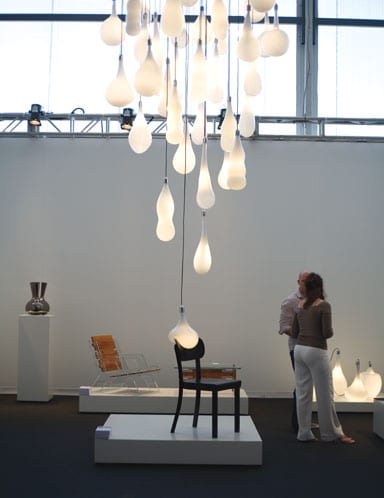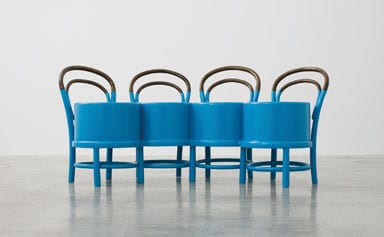
words Marisa Mazria-Katz
Among the palm fronds and lush green moss of Design Miami’s Beyond Organic exhibition, world-renowned designers discussed how pregnancy, depression, and even motorcycle accidents affected their work. Yet, given the state of Wall Street, all anyone could think about was: would anyone actually buy anything other than the event’s trendy canvas tote?
“There was a lot of concern about what was the real status of the market,” said Design Miami principal Craig Robins, who is prone to hyperbole. “Would people come to one of the most important cultural happenings in the world? And if they came, would that lead to any commercial transactions? What happened was on every level Design Miami surpassed certainly the worst fears, and in most cases the expectations.”
British designer Tom Dixon’s prognosis at the start of the fair differed from Robins’ post-event analysis. “Clearly none of us are going to sell our pieces this year,” he commented, from atop a Campana brothers’ Banquete Chair with Pandas. Just two days after the opening, though, Dixon’s bleak predictions seemed to fade as sales were made.
Perhaps the most striking feature of Design Miami was the temporary tent it was housed in. Created by New York’s Aranda\Lasch, the diaphanous 43,000sq ft reusable structure incorporated wide aisles for crowds, highlighted by the streams of sunlight that leaked through the outer layer’s perforated geometric shapes.
In the centre was Diamantina, an installation from the event’s Designers of the Year, Humberto and Fernando Campana. Originating in the Brazilian duo’s TransPlastic series, Diamantina was wrought like a melted chaise, and comprised apuí (a wicker-like fibre) and chunky fragments of amethyst. The piece was almost certainly the fair’s most skilful use of reprocessed and discarded materials.
But despite the deepening financial crisis, Kenny Schachter/Rove Projects sold a complete version of Zaha Hadid’s Kloris (2008), as well as some of Arik Levy’s newest creations. One of the fair’s top dealers, Schachter acknowledged the plunging stock markets with a “recession corner”, which featured brightly coloured signs blasting “everything must go” and “cheap stock”.
Down the street from the tent was the first-time exhibit from Villa Moda founder and Kuwaiti royal Sheikh Majed al Sabah. Incense hung in the air, dates were served and traditional Arabic coffee was poured in his Al Sabah Art & Design Collection lounge.
Not only did Al Sabah succeed in creating the most hospitable ambience – imagine a souk in downtown Damascus – he also showed some of the fair’s best work. Al Sabah displayed young Dutch product designer Pieke Bergmans’ Crystal Virus – glass bubbles that languidly lay on top of restored Middle Eastern mother-of-pearl furniture.
Although the dithering economy may rule out further investment in design, the atmosphere in Miami remained lively, if not entirely carefree. Perhaps the event could be summed up best by one of Arik Levy’s films, about a sparkler, which he screened at the event’s Design Talk.
“Kids enjoy sparklers all the way to the end,” said Levy. “When adults see it get to the middle, we prepare ourselves mentally for the end. But kids, they don’t plan.”




















